Hecatompylos (Šahr-e Qumis)
Q1518300Hecatompylos: one of the capitals of the ancient Parthian Empire. The identification with Šahr-e Qumis is not uncontested.
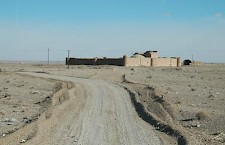
The first photo shows a caravanserai along the main road from Tehran to Mashad, or, to use the ancient name: along the Silk road from Rhagae to Susia. It is near modern Qosheh. Here, a visitor of Hecatompylos, since the days of Arsaces I (r.247-217) the residence of the Parthian Empire, has to leave the highway. According to its (Greek) name, the city once had "hundred gates", because it was "the meeting-place of all the roads leading to the surrounding districts".note
Today, the plain of Šahr-e Qumis is absolutely deserted, but everywhere, you can see the remains of the old city, which was, according to the Greek author Appian of Alexandria, founded by the Seleucid king Seleucus I Nicator.note In fact, it must have been a refoundation, because we know that Alexander the Great visited the place after the death, in nearby Choara, of his opponent Darius III Codomannus. This happened in the summer 330, about a generation before Seleucus. Besides, the plain is littered with millions of potsherds, and many of them date back to the Early Iron Age.
On the plain of Šahr-e Qumis, you can see several ancient mounds. Only a few of them have been properly excavated, and the area between them has mostly been ignored. Yet, the first results are encouraging: several architectural remains have been identified, which appear to have belonged to a palace-like building and a fort. Elsewhere, archaeologists found tombs, ceramics, seals, and two lists with personal names that date back to the year 170 of the Arsacid era (= 78 BCE).
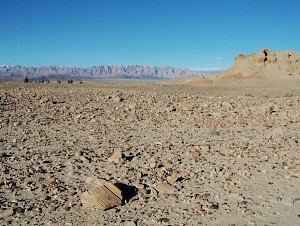
Today, the dry mountain winds blow the sand and dust from the site to the desert. This is the only sound you hear at Šahr-e Qumis; otherwise, there is a deafening silence, and you will find it hard to imagine that this once was a busy city where many people lived.
But it becomes understandable when we realize that it was situated on the southern slope of the Elburz mountains, the large natural obstacle between the Caspian Sea and the arid central plateau of Iran. Hardly any rain falls in the area of Hecatompylos, but yet, there is water: in the spring, countless flash floods flow to the south from the mountains, and there are several artesic wells. The zone along the foothills of the Elburz is therefore, essentially, a small strip of more or less fertile land. The capital of the Parthian Empire could feed and refresh many people.
The field of sherds at Šahr-e Qumis measures some 7 x 4 kilometers or 28 km², which suggests that ancient Hecatompylos must have boasted tens of thousands of inhabitants. They have left not only sherds; when you look carefully you can find other objects as well. We discovered a metal ring and a small piece of lapis lazuli.
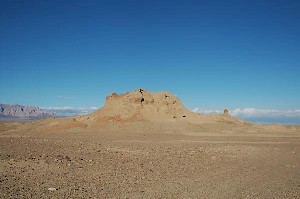
The architectural remains of Hecatompylos are hard to interpret. This giant (56 meter in diameter) mud brick monument is called Mound I or the Naqqareh Khaneh (the "house of the kettle drum"), and the sherds suggest that it is relatively young.
Another interesting part of the Šahr-e Qumis site is known as Mound VI. It is a structure of about 50 x 30 meters with several towers and a courtyard. Mound VI must have been some kind of fortress, and can stylistically be compared to similar fortifications from Aria and Bactria from the first centuries BCE and CE. It is therefore Parthian. Later, at least one of the towers was used as a Sasanian burial site.
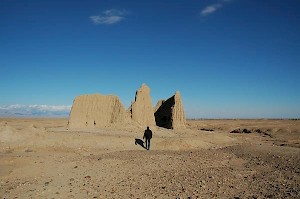
The Square Building, which has two stories, may or may not have belonged to the royal palace in Hecatompylos. The Parthian rulers liked to spend the winter in Ctesiphon in Babylonia, the spring in Rhagae, and appear to have lived in Hecatompylos during the autumn. All these cities are situated along the Silk Road.
Several hills like these have been identified as tombs of human beings and animals. There are several of them, as one would have expected from a large city. Usually, the bones were gnawed at by birds, which suggest that the dead had been exposed. This was a common Zoroastrian practice (cf. the "towers of silence" near modern Yazd).
At least three types of vaults, constructed of long mud-bricks, have been identified in these tomb mounds. On one site (Mound VII), a remarkable burial of human and horse skulls, mixed with the bones of pigs, gazelles, and dogs were found. The burial can be dated (by coins) to the eighth decade BCE.
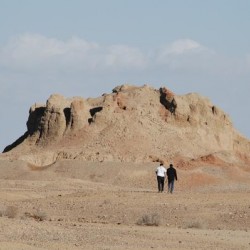 Hecatompylos, Hill 1 |
 Hecatompylos, Hill 1, Clandestine excavation |
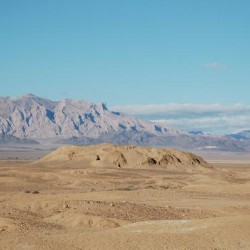 Hecatompylos, Hill 2 |
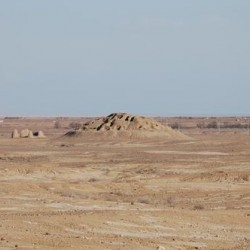 Hecatompylos, Hill 3 |